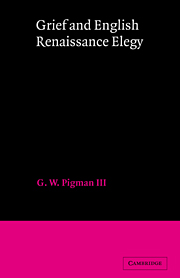But truly, you deal with me like a physician that, seeing his patient in a pestilent fever, should chide him instead of ministering help, and bid him be sick no more. (Sidney, The Countess of Pembroke's Arcadia)
Consolations for death are as old as anything in literature, and the commonplaces of consolation are remarkably tenacious, as if those who use them are bent on proving there is nothing new under the sun. Nevertheless the modern reader of sixteenth-century literature is likely to be struck by the harsh tone of its consolations. The consoler often sounds angry, chides, and gives reasons why the bereaved should not mourn. By the beginning of the seventeenth century a shift in feeling has occurred, and some of the letter-writing formularies, the foremost repository of precepts for consolation, prescribe a gentler, less domineering type of consolation. The change in attitude is clearest in the different role assigned to expression of sympathy. The letter of consolation is becoming the letter of condolence.
The sixteenth century inherits some important assumptions from ancient consolation. First, man is distinguised from the beasts by his possession of reason, a higher faculty than the ‘passions’; man is most human when most rational. Second, the pain of bereavement stems from mistaken ideas about death, not from the rupture of an emotional bond.
